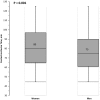Impact of Sex and Contact-to-Device Time on Clinical Outcomes in Acute ST-Segment Elevation Myocardial Infarction-Findings From the National Cardiovascular Data Registry
- PMID: 28077385
- PMCID: PMC5523636
- DOI: 10.1161/JAHA.116.004521
Impact of Sex and Contact-to-Device Time on Clinical Outcomes in Acute ST-Segment Elevation Myocardial Infarction-Findings From the National Cardiovascular Data Registry
Abstract
Background: Emergent myocardial reperfusion via primary percutaneous coronary intervention is optimal care for patients presenting with ST-segment elevation myocardial infarction (STEMI). Delays in such interventions are associated with increases in mortality. With the shift in focus to contact-to-device (C2D) time as a new perfusion metric, this study was designed to examine how sex affects C2D time and mortality in STEMI patients.
Methods and results: Clinical data on male and female STEMI patients were extracted and analyzed from the National Cardiovascular Data Registry from July 1, 2008 to December 31, 2014. A total of 102 515 patients were included in the final analytic cohort. The median C2D time in female patients with STEMI was delayed when compared to male patients (80 [65-97] versus 75 [61-90] minutes; P<0.001). The unadjusted mortality was higher in female patients when compared to male patients with STEMI (4.1% versus 2.0%; P<0.001). For every 5-minute increase in C2D time, the adjusted odds ratio for mortality was 1.04 (95% CI, 1.03-1.06) for female patients with STEMI and 1.07 (95% CI, 1.06-1.09) for male patients (P for sex by C2D interaction=0.003).
Conclusions: To date, this is the largest analysis of STEMI patients that measures the impact of the new recommended C2D reperfusion metric on in-hospital mortality. Female STEMI patients have longer C2D times and increased mortality. The disparity can be improved and survival can increase in this high-risk patient cohort by decreasing systems issues that cause increased reperfusion times in female STEMI patients.
Keywords: ST‐segment elevation myocardial infarction; disparities; mortality; reperfusion; sex‐specific.
© 2017 The Authors. Published on behalf of the American Heart Association, Inc., by Wiley Blackwell.
Figures




Similar articles
-
Utilization, Characteristics, and In-Hospital Outcomes of Coronary Artery Bypass Grafting in Patients With ST-Segment-Elevation Myocardial Infarction: Results From the National Cardiovascular Data Registry Acute Coronary Treatment and Intervention Outcomes Network Registry-Get With The Guidelines.Circ Cardiovasc Qual Outcomes. 2017 Aug;10(8):e003490. doi: 10.1161/CIRCOUTCOMES.116.003490. Circ Cardiovasc Qual Outcomes. 2017. PMID: 28794118
-
Impact of Regionalization of ST-Segment-Elevation Myocardial Infarction Care on Treatment Times and Outcomes for Emergency Medical Services-Transported Patients Presenting to Hospitals With Percutaneous Coronary Intervention: Mission: Lifeline Accelerator-2.Circulation. 2018 Jan 23;137(4):376-387. doi: 10.1161/CIRCULATIONAHA.117.032446. Epub 2017 Nov 14. Circulation. 2018. PMID: 29138292
-
Symptom-Onset-To-Balloon Time, ST-Segment Resolution and In-Hospital Mortality in Patients With ST-Segment Elevation Myocardial Infarction Undergoing Primary Percutaneous Coronary Intervention in China: From China Acute Myocardial Infarction Registry.Am J Cardiol. 2016 Nov 1;118(9):1334-1339. doi: 10.1016/j.amjcard.2016.07.058. Epub 2016 Aug 13. Am J Cardiol. 2016. PMID: 27666173
-
Sex differences in short-term and long-term all-cause mortality among patients with ST-segment elevation myocardial infarction treated by primary percutaneous intervention: a meta-analysis.JAMA Intern Med. 2014 Nov;174(11):1822-30. doi: 10.1001/jamainternmed.2014.4762. JAMA Intern Med. 2014. PMID: 25265319 Review.
-
False Activations for ST-Segment Elevation Myocardial Infarction.Interv Cardiol Clin. 2016 Oct;5(4):451-469. doi: 10.1016/j.iccl.2016.06.002. Epub 2016 Aug 5. Interv Cardiol Clin. 2016. PMID: 28581995 Review.
Cited by
-
Sex Differences in Prehospital Delays in Patients With ST-Segment-Elevation Myocardial Infarction Undergoing Percutaneous Coronary Intervention.J Am Heart Assoc. 2021 Jul 6;10(13):e019938. doi: 10.1161/JAHA.120.019938. Epub 2021 Jun 22. J Am Heart Assoc. 2021. PMID: 34155902 Free PMC article.
-
Sex Disparities After Coronary Artery Bypass Grafting and Hospital Quality.JAMA Netw Open. 2024 Jun 3;7(6):e2414354. doi: 10.1001/jamanetworkopen.2024.14354. JAMA Netw Open. 2024. PMID: 38861261 Free PMC article.
-
Trends in outcomes of women with myocardial infarction undergoing primary angioplasty-Analysis of randomized trials.Front Cardiovasc Med. 2023 Jan 4;9:953567. doi: 10.3389/fcvm.2022.953567. eCollection 2022. Front Cardiovasc Med. 2023. PMID: 36684569 Free PMC article.
-
Established evidence-based treatment guidelines help mitigate disparities in quality of emergency care.Acad Emerg Med. 2021 Sep;28(9):1051-1060. doi: 10.1111/acem.14235. Epub 2021 Jun 28. Acad Emerg Med. 2021. PMID: 33599040 Free PMC article.
-
Sex-Specific Physiology and Cardiovascular Disease.Adv Exp Med Biol. 2018;1065:433-454. doi: 10.1007/978-3-319-77932-4_27. Adv Exp Med Biol. 2018. PMID: 30051400 Free PMC article. Review.
References
-
- O'Gara PT, Kushner FG, Ascheim DD, Casey DE Jr, Chung MK, de Lemos JA, Ettinger SM, Fang JC, Fesmire FM, Franklin BA, Granger CB, Krumholz HM, Linderbaum JA, Morrow DA, Newby LK, Ornato JP, Ou N, Radford MJ, Tamis‐Holland JE, Tommaso CL, Tracy CM, Woo YJ, Zhao DX, Anderson JL, Jacobs AK, Halperin JL, Albert NM, Brindis RG, Creager MA, DeMets D, Guyton RA, Hochman JS, Kovacs RJ, Kushner FG, Ohman EM, Stevenson WG, Yancy CW; American College of Cardiology Foundation/American Heart Association Task Force on Practice Guidelines . 2013 ACCF/AHA guideline for the management of ST‐elevation myocardial infarction: a report of the American College of Cardiology Foundation/American Heart Association Task Force on Practice Guidelines. Circulation. 2013;127:e362–e425. - PubMed
-
- Collins SD. Acute myocardial infarction in women: is there a sex disparity between door‐to‐balloon time and clinical outcomes? Cardiovasc Revasc Med. 2012;13:125–127. - PubMed
-
- Kushner FG, Hand M, Smith SC Jr, King SB III, Anderson JL, Antman EM, Bailey SR, Bates ER, Blankenship JC, Casey DE Jr, Green LA, Hochman JS, Jacobs AK, Krumholz HM, Morrison DA, Ornato JP, Pearle DL, Peterson ED, Sloan MA, Whitlow PL, Williams DO. 2009 focused updates: ACC/AHA guidelines for the management of patients with ST‐elevation myocardial infarction (updating the 2004 guideline and 2007 focused update) and ACC/AHA/SCAI guidelines on percutaneous coronary intervention (updating the 2005 guideline and 2007 focused update) a report of the American College of Cardiology Foundation/American Heart Association Task Force on Practice Guidelines. J Am Coll Cardiol. 2009;54:2205–2241. - PubMed
-
- Krumholz HM, Bradley EH, Nallamothu BK, Ting HH, Batchelor WB, Kline‐Rogers E, Stern AF, Byrd JR, Brush JE Jr. A campaign to improve the timeliness of primary percutaneous coronary intervention: door‐to‐balloon: an alliance for quality. JACC Cardiovasc Interv. 2008;1:97–104. - PubMed
Publication types
MeSH terms
LinkOut - more resources
Full Text Sources
Other Literature Sources

